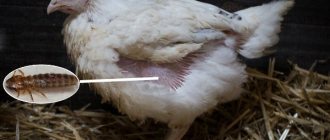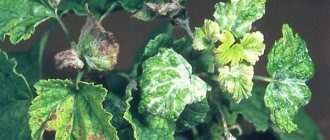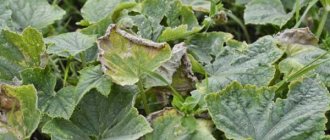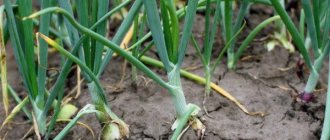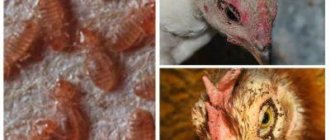Signs of cabbage being damaged by slugs
Gastropods, despite the lack of a shell, are very tenacious and hardy. During the daytime, slugs are almost impossible to see on the site, because they hide from sunlight in dark and damp places: in weeds, under the top leaves of cabbage.
Late in the evening, pests crawl out of hiding and feast on tender young cabbage leaves until the morning. They are especially active in rainy weather when air humidity is high.
It is easy for experienced gardeners to detect the pest and recognize it by holes of different sizes on the leaves. The voracious mollusks leave behind a trail of mucus. It protects the body from drying out and helps the pest move. As the mucus dries, it acquires a silvery tint, which is clearly visible on cabbage leaves.
Attention! If you examine the heads of cabbage, you can find the passages that pests make in them.
Damage caused
Slugs are large pests that, in the absence of special treatment, can destroy the entire cabbage crop. However, the degree of damage depends not only on their size, but also on their number.
Mollusks are endowed with powerful jaws, so they destroy plantings with great speed. They do not eat the entire head of cabbage, but damage it so much that it becomes unsuitable for consumption or further storage. This pest attacks all types of cabbage: white cabbage, broccoli, Peking cabbage, cauliflower, Brussels sprouts.
Reference. Red cabbage suffers less from slug infestations than other varieties.
In addition to the fact that pests eat the succulent shoots of the plant, they spread fungal infections and other diseases that affect the volume of the harvest. Their saliva contains a special enzyme, which causes the leaves of the vegetable to become covered with dark spots, after which signs of rot appear.
Sometimes the damage caused by diseases is greater than that caused by mechanical damage from slugs.
Overview of the pest
A slug or slug is a gastropod that has lost its shell during its evolution. In most cases, this is the name given to pulmonate snails belonging to the stalked-eyed group. The loss of the shell occurred due to a lack of calcium in the diet, as well as the transition to dense thickets of plants. Wet soil is the main place where mollusks live.
The slug itself consists of a head, legs and body, which can also be called visceral mass. Tentacles grow on the head, acting as a sensory organ. The movement of a slug occurs as a result of contraction of its body.
Slugs on cabbage
The mucus secreted by the mollusk helps it move and also repels its natural enemies. It can be liquid and thick. The secretion produced by the slug is hygroscopic. It is capable of absorbing moisture from the air.
Additional Information! During mating, one slug chases the other, after which they wrap each other in their own genitals. If after mating it is not possible to unwind back, one of the individuals eats its own or its partner’s genitals.
During the day, slugs live in dark, damp places, and after sunset they go to cabbage beds, where they remain until the morning. During the night they gnaw heads of cabbage, mature and young leaves.
During the day, they can hide under the plant itself or climb under the upper leaves. In cool and damp weather they remain active all day.
Slug danger for cabbage:
- Cabbage on which cold and slippery shellfish have crawled is unpleasant to eat.
- They voraciously eat leaves and drink cabbage juice.
- Damaged heads of cabbage have a shorter shelf life.
- Slugs act as carriers of dangerous diseases, including powdery mildew.
- Mucus on cabbage leaves contributes to rotting of the fruit.
Ways to get rid of slugs on cabbage
To protect cabbage from slugs, various methods are used. Folk remedies are considered the safest, but chemicals are the most effective.
Chemicals
The easiest way is to use chemicals to control slugs. The main active ingredient of such drugs is metaldehyde. Solid, insoluble granules act upon contact and ingestion.
The most common chemical repellents for slugs:
- " Meta ". Has a contact-intestinal effect. This drug is produced in dry form. After the granules are scattered in the space between the rows, the slugs begin to group under the leaves of the cabbage heads and die there. Meta is also produced in powder form. They powder heads of cabbage with it for prevention. The drug is used no later than 3 weeks before harvesting cabbage from the beds.
- "Ulicide." The product is made on the basis of iron phosphate salt. It is considered not as toxic to people and animals as the previous one. When the active substance enters the pest’s body, it causes very rapid dehydration. The slug dies within 40 minutes. This product is used no more than 2 times during the entire season.
- "Ecokiller". A natural preparation, which is made on the basis of diatomite, in powder form. It also has a dehydrating effect on pests. At the same time, Ecokiller is not dangerous for people and animals. For 1 sq. m scatter 20 g of powder.
- "Slug eater." The product is produced in the form of granules. In 3-4 days it causes the death of the slug population. For 10 sq. m of beds use 30 g of the drug.
When using chemicals against pests, it is advisable to use personal protective equipment: gloves, a face mask and clothing made of thick fabric.
Traditional methods
Often gardeners prefer to use traditional methods of pest control. Ingredients for cooking are always available.
The most common means:
- Coffee solution. Both ground and instant coffee are used for spraying. The drink is made very strong. After cooling, spray the heads of cabbage and the space between them.
- A solution of ammonia. To combat slugs, a solution is often used, which is prepared from 1 part ammonia and 6 parts water. Spraying helps effectively control pests, but does not harm cabbage. The main thing is to use this method no more than once a week, so as not to cause the vegetables to dry out.
Agrotechnical techniques
Many summer residents create a kind of obstacle course that prevents slugs from getting to the cabbage. Sand, crushed shells and eggshells or sawdust are scattered around the perimeter of the beds. Soft-bodied pests are not able to overcome such a barrier.
How else to deal with them:
- Early varieties are covered with film. Pests cannot tolerate heat. During the daytime, a greenhouse effect is created under the film. This leads to the death of the slugs. This method is not used for late varieties, as this often leads to rotting of the roots.
- Young cabbage is watered with warm water (about 50°C). This will not harm the plant, but the pests will definitely die.
- Regularly feed the crop with mineral fertilizers, for example, superphosphate or potassium salt. They are scattered around plants.
- Make sure there are no weeds around the garden bed.
Mechanical methods
The easiest way is to walk around the area every day and collect slugs by hand . This method does not require additional costs or the use of chemicals, but is not the most effective.
To simplify the process, traps are made on the site. Slugs love the aroma of beer, jam, compote and syrup. Trimmed bottles are dug into the garden bed and filled with treats for pests. Slugs have a very keen sense of smell. By the next morning there will be many individuals in each trap.
Important! The trap method also has its drawbacks. Beneficial insects, such as bees, will also respond to the bait.
Mechanical way of fighting
There are many ways to get rid of slugs on cabbage. The mechanical method of control involves manual processing of cabbage. Of course, it won’t be possible to gather everyone, but you still shouldn’t neglect this method. If you take into account the habits and preferences of slippery mollusks, work efficiency can be increased significantly.
See also
How to deal with black leg in cabbage, what to do, proper treatmentRead
First of all, you can lay out traps that are made from buckets, slate sheets, remnants of boards and old bags. The arsenal should be located near the beds that are being cultivated. In the evening, you can organize a raid: there will be many “criminals” on the surfaces of the decomposed materials. By placing shellfish in salt water, you can quickly destroy them: salt is harmful to them. This method can be used repeatedly.
When choosing a method for dealing with slugs on cabbage, you can use a trick. Since it is quite difficult for them to crawl on surfaces with ribs and convexities, barriers can be built from crushed stone, egg shells and other available materials on the approaches to the garden and beds. This will prevent slugs from getting to the cabbage.
Superphosphate can be used to prevent slugs. It quickly absorbs mucus, as a result of which the movement of the mollusk will become impossible. If you dig ditches filled with water around the plantings, this will help repel the pest. This protection of cabbage from slugs is effective and simple.
The most effective methods
All of the above methods have varying effectiveness. The safer the product, the worse it works. Therefore, in extreme cases, the most powerful drugs are used.
Killer mixture against cabbage slugs
The entire soil between the rows and individual heads of cabbage is pollinated with lime. This will prevent pests from hiding in cracks in the ground.
After this, the chemical preparation “Thunderstorm” is scattered. Now this is the most effective remedy for slugs. It acts precisely, killing these pests. Made with metaldehyde.
Experience using Groza has shown that the granules attract slugs. This quickly leads to the death of the entire population. The drug is relatively safe for birds, animals and beneficial insects.
Additional tips for growing cabbage
In order for the heads of cabbage to grow large and resistant to external factors, do not forget about fertilizing the soil. Starting from the stage of the appearance of young plants, the soil is fed with potassium salt (potassium sulfate or potassium chloride) or superphosphate. During autumn and spring digging, organic fertilizers are also applied, which saturate the soil with useful substances, improve its acidity and serve as the prevention of many diseases.
During the growing season, cabbage should receive at least 3 fertilizers, which are applied in both dry and liquid form. In addition to slugs, cabbage heads can be affected by cabbage aphids, cabbage flies, cruciferous flea beetles, cabbage moths, and cabbage leaf beetles. Cabbage aphids drink juices from the leaves, which leads to complete dehydration of the vegetable. To prevent its attack, it is recommended to plant carrots between cabbage rows (aphids do not like their smell) and destroy anthills on the site.
The cabbage fly lays larvae on heads of cabbage, the penetration of which into the roots leads to the death of the plant. To prevent this, before planting cabbage, you should dig deeply (no less than 30 cm), do not plant the vegetable in the same place for several years in a row, and protect the root part with any waterproof material.
You will be interested in learning how to properly plant and grow cabbage.
The cruciferous flea beetle can be an unpleasant “guest” on cabbage leaves. These small bugs gnaw holes in the leaves of the plant, after which it dries out. Fleas lay larvae that live in the ground, so the main preventive measure here will also be deep digging of the soil and thorough fertilization.
If you notice slugs on your site, you should not panic and reproach yourself for not taking good care of the crop, because any plant is susceptible to diseases and pest attacks. Knowing how to deal with them, you will protect your plantings from harmful insects and save your harvest.
Slug-resistant cabbage hybrids
Breeders are breeding hybrids that are less susceptible to attack by slugs:
- F1 sprinter. It has a dense and oval head weighing 1-1.5 kg. The color in section is milky yellow. The hybrid has good taste. Pest attacks only occur when agricultural practices are incorrect.
- Start of F1. This cabbage is designed for dense planting. Weakly susceptible to diseases and pests.
- Transfer F1 . This hybrid is practically not affected by pests and diseases. The disadvantage is that the shelf life of heads of cabbage after harvesting from the garden does not exceed 1 month.
- Aggressor F1 . It has good immunity, due to which it is rarely damaged by pests. This is an undemanding crop that tolerates unfavorable conditions well.
Mustard and ammonia
Here you can improvise; any substance that is safe for humans and plants, but unpleasant for a naked snail, will do. For example, you can pour water with red pepper, salt, and vodka over the cabbage. But the most popular recipe among summer residents is the following solution. Take 2 tablespoons of ammonia per liter of water, add 15 g of dry mustard. It is also recommended to spray with this solution late in the evening, when a hungry slug should already be “on the way.” Without direct contact with the pest, the product will not work.
Preventive measures
Getting rid of slugs is much more difficult than preventing their appearance. Therefore, gardeners try to pay attention to prevention:
- Pests love dark and damp places. They breed under fallen leaves and rotting firewood. It is important to regularly clear the area of such debris and remove weeds.
- The top layer of soil is loosened to prevent moisture from accumulating.
- Set up sand obstacles around the beds. This is especially important if the site is located near bodies of water.
- Dig in the spring. At the end of summer, slugs lay eggs in the upper layers of the earth. The larvae appear in late spring. If you dig up the garden in early spring, all the embryos will die.
- After harvesting, all plant debris is immediately collected.
- Tobacco dust or ash is sprinkled around the holes every 2 weeks.
- Sprinkle the soil with superphosphate. This substance quickly absorbs mucus, causing slugs to lose their ability to move.
- Pests often use the lower leaves of cabbage as a home. Experts recommend removing these parts of the plant in a timely manner.
Prevention measures
In order not to waste time on pest control, you should worry about the safety of vegetables in advance. There are a number of preventive measures that can prevent a slug invasion. They include both drug and traditional methods. The main attention should be paid to the cleanliness and care of the garden plot.
You should definitely get rid of last year's compost piles. Cabbage should be planted freely, since dense foliage can also serve as an attractive “residence” for mollusks. Throughout the season, care must be taken to collect weeds and mow the grass in a timely manner so that slugs do not hide in tall vegetation.
Gardeners advise covering early heads of cabbage with film. The created greenhouse conditions under the scorching sun become unbearable for slugs and they die. Many summer residents say that mollusks are afraid of nettles and die from its burns. To do this, nettle grass is wrapped around each head of cabbage (instead of nettle, sometimes hot pepper is used).
Find out more about the benefits and harms of cabbage for the human body.
Helpful Tips and Mistakes to Avoid
To make cabbage resistant to diseases and various pests, it is regularly fed. Superphosphate or potassium salt is added to the soil. In autumn and spring, organic matter is added during digging. It allows you to saturate the soil with useful substances and improve its acidity. Organic matter serves as a means of prevention against slugs, as it increases plant immunity. During the growing season, cabbage is fed at least 3 times.
In addition to slugs, the crop is attacked by aphids, cruciferous flea beetles, cabbage beetles, and leaf beetles. To prevent the appearance of most pests, it is recommended to plant carrots between the rows of cabbage.
It is important to monitor the humidity level. With excessive watering, the occurrence of slugs is guaranteed.
Causes and signs of appearance
You can suspect the appearance of slugs in cabbage beds by the presence of gnawed holes and leaf plates that look like a net. At this stage, it is necessary to choose the appropriate method and take action quickly, otherwise damage will be caused to the entire crop. Another sign of their attack is the presence of silvery streaks - dried mucus.
Signs of slugs
Important! The greatest activity of these pests occurs during cool and rainy summers, preceded by a wet spring and mild winter.
Under optimal conditions, slugs will attack cabbage even during the daytime. If the summer is hot during the day, they will hide in damp soil, basements, compost and other cool places with high humidity.
Mollusks can attack the entire garden, including tomato plants, but they eat cabbage with the greatest pleasure. Its leaves contain a large amount of juice and minerals that are valuable for the life of these organisms.
